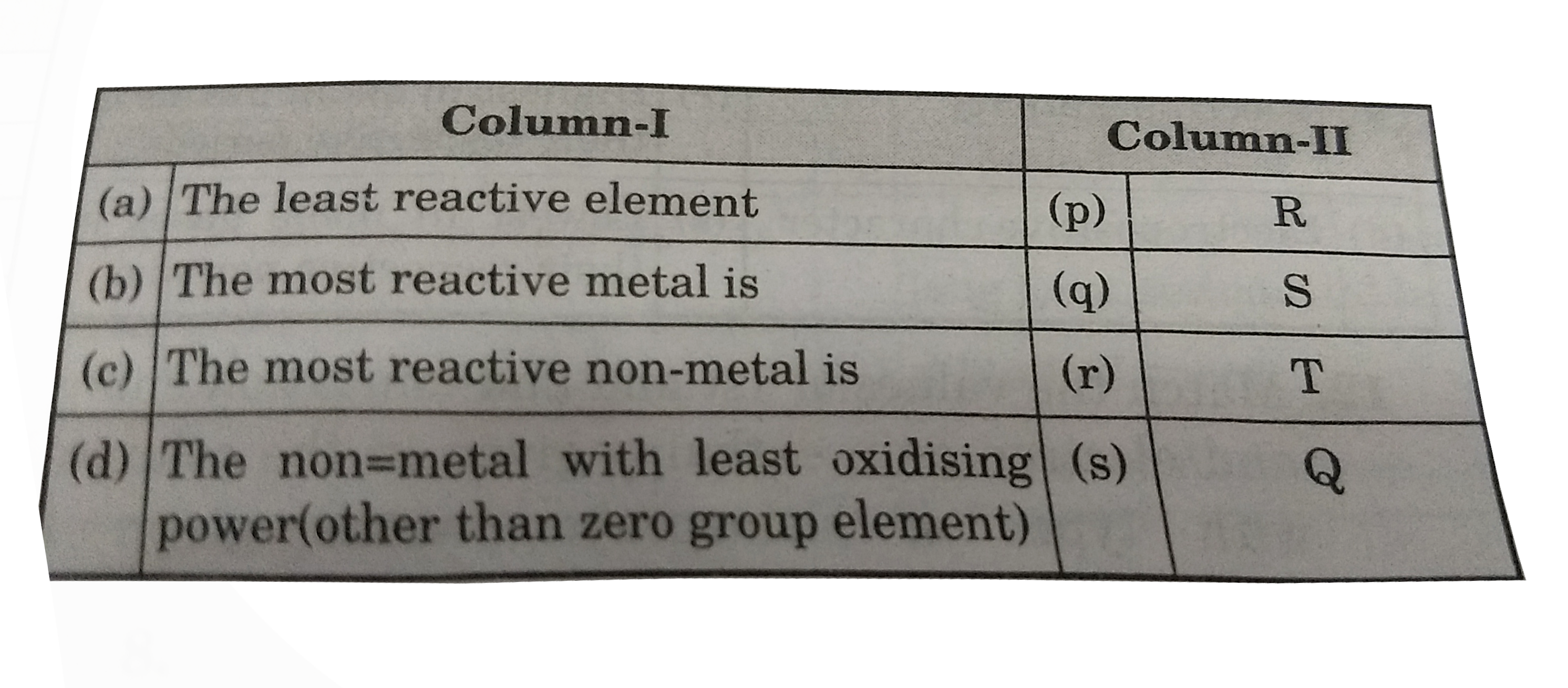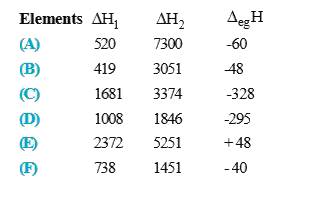The first (ΔiH1) and the second (ΔiH2) ionization enthalpies (in kJ mol−1) and the (ΔegH) electron gain enthalpy (in kJ mol−1) of a few elements are given below:
ElementsΔH1ΔH2ΔegHI5207300–60II4193051–48III16813374–328IV10081846–295V23725251+48VI7381451–40
Which of the above elements is likely to be :
(a) the least reactive element.
(b) the most reactive metal.
(c) the most reactive non-metal.
(d) the least reactive non-metal.
(e) the metal which can form a stable binary halide of the formula MX2(X=halogen).
(f) the metal which can form a predominantly stable covalent halide of the formula MX (X=halogen)?
P
Q
S
U
The correct Answer is:B
Metal having low IE1 and higher IE2 corresponds to alkali metal. Hence, Q is most reactive metal (easily forms cation)
Topper's Solved these Questions
Similar Questions
The first (ΔiH1) and second (ΔiH2) ionisation enthalpies (inkJmol−1) and the (ΔegHө) electron gain enthalpy (inkJmol−1) of a few elements are given below:
Elements(ΔiH1)(ΔiH2)ΔegHөI5207300−60II4193051−48III16813374−328IV10081846−295V23725251+48VI7381451−40
Which of the above elements is likely to be
a. the least reactive element.
b. the most reactive metal.
c. the most reactive non-metal.
d. the least reactive non-metal.
e. the metal which can form a stable binary halide of the formula MX2 (X=halogen).
f. the metal which can form a predominantly stable covalent halide of the formula MX(X=halogen).
View SolutionThe first (ΔH1) and second (ΔH2) ionisation enthalpies (in kJmol−1) and the (ΔHeg) electron gain enthalpy (in kJmol−1) of a elements are given below:

Based on the above information match the following columns.

View Solution
Knowledge Check
The first (ΔiH1 and second (ΔiH2 ionization enthalpies (in kJ/mol) and electron gain enthalpy (in kJ/mol) of few elements are given below:
ElementsΔiH1ΔiH2ΔegHI5207300−60II16813374−328III8991757−48IV23725251+48
Which of the following is likely to be an alkali metal?AI and IVBV and IICII and VDIV and V
The first (Δi,H1) and the second (Δ,H2) ionisation enthalpies (in kJ mol−1 ) and the (ΔegH) electron gain enthalpy (in kJ mol−1 ) of a few elements are given below :

Which of the above elements is likely to be :
a reactive metal
View SolutionThe first (Δi,H1) and the second (Δ,H2) ionisation enthalpies (in kJ mol−1 ) and the (ΔegH) electron gain enthalpy (in kJ mol−1 ) of a few elements are given below :

Which of the above elements is likely to be :
the least reactive element?
View SolutionThe second electron gain enthalpies (in kJ mol−1) of oxygen and sulphur respectively are:
View SolutionThe second electron gain enthalpies (in kJ mol−1) of oxygen and sulphur respectively are:
View SolutionThe second electron gain enthalpies (in kJ mol−1) of oxygen and sulphur respectively are:
View SolutionThe first and second ionization enthalpies and electron gain enthalpy of some elements are as given below:

A metal which can form a stable binary halide of the type MX2 is (X : Halogen)
View SolutionThe first and second ionization enthalpies and electron gain enthalpy of some elements are as given below:

The metal which can predominantly form a stable cova- lent halide of the type (MX) (X : Halogen)
View Solution
